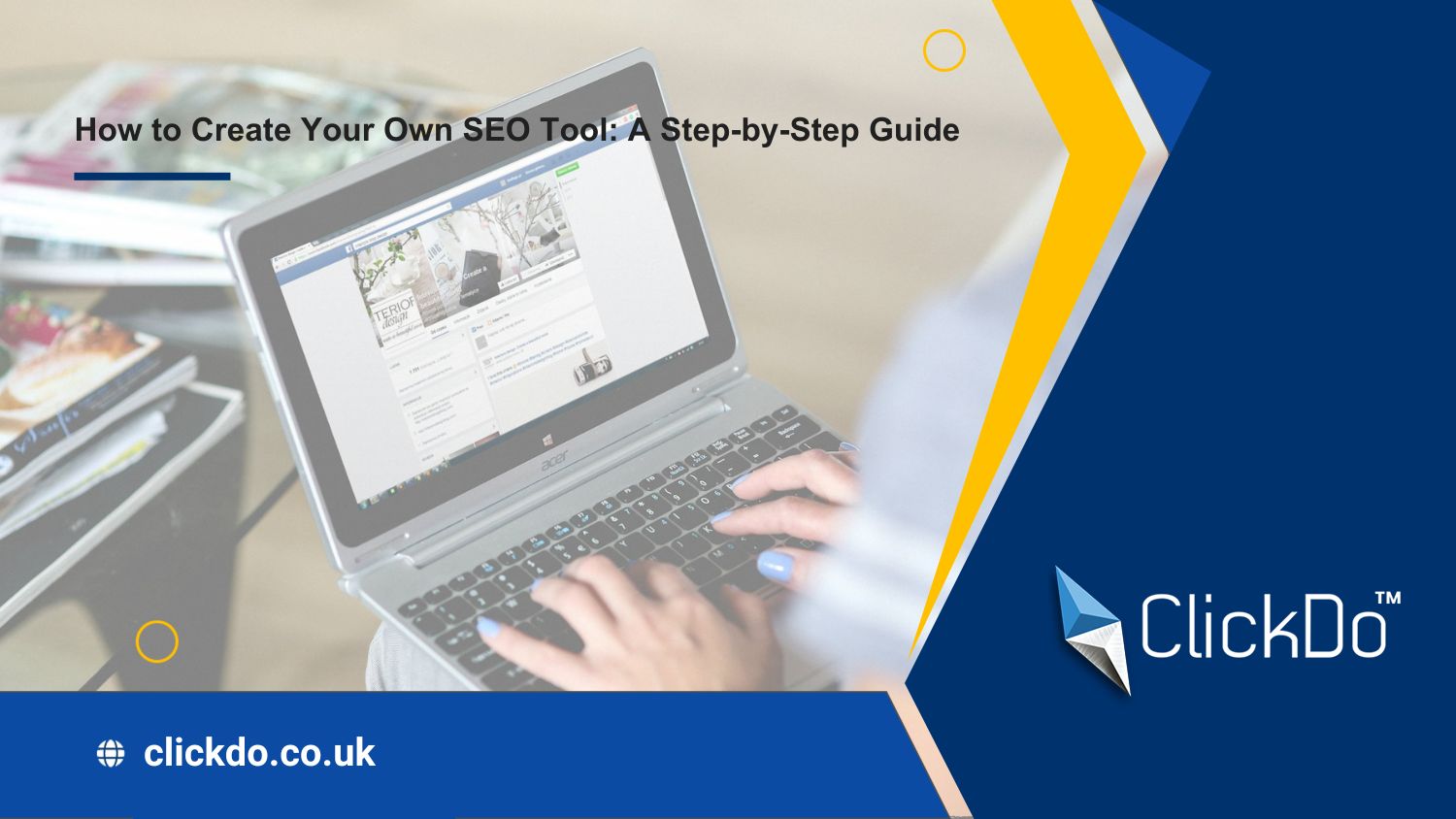
How to Create Your Own SEO Tool: A Step-by-Step Guide
SEO tools are pivotal in navigation through the complex setting of online visibility. They help decipher the algorithmic enigma that is Google, which enables your site to perform better in search results. But why stop at generic solutions?
The creation of a custom SEO tool might be the strategic edge you need. Tailoring a tool to your specific needs can significantly amplify your website’s performance.
In fact, well-optimized websites experience substantial increases in traffic and user engagement. 60% of marketers say that SEO is their highest quality source of leads. It’s essentially transforming your online presence from being unnoticed to becoming a central hub for your target audience.
Let’s dive into how custom SEO tools and smart outsourcing strategies can improve your digital footprint!
Table of Contents
3 Reasons to Develop Your Own SEO Tool

The development of a personalized SEO tool offers several advantages that cater to specific needs and challenges faced by businesses:
1. Customization and flexibility
Tailoring an SEO tool to your specific requirements allows for greater control over features and functionalities. Custom tools can evolve with your SEO services and strategies and adapt to industry changes that ensure long-term relevancy and effectiveness.
2. Integration with existing systems
A bespoke SEO tool can seamlessly integrate with your current digital infrastructure, from analytics platforms to content management systems. This integration enhances workflow efficiency and data accuracy, which provides a unified view of your SEO performance.
3. Specific SEO solutions
Custom tools can be designed to tackle unique SEO hurdles specific to your industry or website architecture that offer solutions that off-the-shelf tools may not provide.
A Step-by-Step Guide to Create Your Own SEO Tool

Creation of your own SEO tool involves a series of steps from conceptualization to launch.
Here’s how to get started:
Step 1: Define your tool’s purpose and features
Before starting the development, it’s necessary to clearly define the goals and functionalities of your custom SEO tool. This step lays the foundation for the entire project, guides subsequent decisions, and ensures alignment with your objectives.
For instance, if your website targets a niche audience interested in sustainable living, your custom SEO tool might prioritize features like carbon footprint tracking, eco-friendly product recommendations, and green lifestyle content optimization.
We also recommend collaborating closely with stakeholders to gather insights into their specific needs and pain points.
Step 2: Conduct market research
Conduct market research, which involves analyzing competitors’ offerings, identifying market gaps, and understanding user preferences and pain points. It will help you shape your custom SEO tool’s features and functionalities.
Let’s say you’re creating an SEO tool for e-commerce businesses, market research might reveal a need for a feature that analyzes competitor pricing strategies, predicts consumer behavior trends, and suggests product optimizations based on market demand.
You can utilize a combination of qualitative and quantitative research methods that include surveys, interviews, and competitor analysis and rank tracker tools, to gain a comprehensive understanding of the market.
Step 3: Choose the right technologies
Selection of the right technologies for your custom SEO tool is key to its success. Consider factors such as scalability, compatibility, and ease of maintenance to ensure the tool meets both current and future needs.
If your tool requires real-time data processing and analysis, you might opt for cloud-based solutions like Amazon Web Services (AWS) or Google Cloud Platform (GCP). These platforms offer scalability and robust data processing capabilities to handle large volumes of SEO data effectively.
You can consult with experienced developers or technology experts to evaluate the pros and cons of different technology options based on your specific requirements. Additionally, prioritize technologies that align with your team’s expertise to facilitate smoother development and maintenance processes.
Moreover, you will create your own SEO tool much faster if you outsource its development. Consider this comprehensive guide to IT project outsourcing. It explains a 6-step process of outsourcing, provides a list of services you can outsource, and gives a glance at how much it will cost.
Step 4: Create UI/UX design
Designing a user-friendly interface is important for ensuring your custom SEO tool is intuitive and easy to navigate. It involves creating wireframes, mockups, and prototypes to visualize the tool’s layout and functionality, focusing on enhancing the user experience.
For instance, when you design a dashboard for your SEO tool, prioritize clarity and simplicity by organizing information logically, using intuitive icons and labels, and minimizing clutter.
Moreover, consider conducting usability testing with real users to identify pain points and areas for improvement in your design. Aim for consistency in design elements, such as colors, fonts, and button styles, to maintain a cohesive user experience across the tool.
Step 5: Develop and test
Development and testing are critical phases in creating a custom SEO tool. During development, the codebase is implemented according to the defined requirements, while testing involves rigorous quality assurance to identify and rectify any bugs or performance issues.
If your tool includes a feature for keyword analysis, developers will write code to fetch and process keyword data from APIs or databases. Subsequently, testers would conduct comprehensive testing, which includes unit testing, integration testing, and user acceptance testing, to ensure the feature functions as intended across different scenarios.
You can implement an agile development approach to iteratively build and test features that allow flexibility and adaptability throughout the development process. Prioritize automated testing wherever possible to streamline the testing process and identify issues early on.
Step 6: Launch and implement marketing
Launching and marketing your custom SEO tool is the final step in bringing it to market and attracting users. In this phase, you plan a strategic launch, leverage various marketing channels to generate awareness and interest, and execute targeted campaigns to reach your target audience.
For instance, you could create a dedicated landing page for your tool and highlight its features, benefits, and unique selling points. Then, utilize email marketing, social media, and content marketing to promote the launch, engage with potential users, and drive sign-ups or downloads.
Prioritize building anticipation and excitement around your tool’s launch by teasing features or offering exclusive access to early adopters. Collaborate with influencers or industry experts to increase your reach and credibility. What’s more, continuously monitor and analyze your marketing efforts to optimize performance and refine your strategy based on user feedback and engagement metrics.
Step 7: Collect feedback and make continuous improvement
Gather user feedback and continuously improve your custom SEO tool for its long-term success. Solicit feedback from users, analyze data and metrics, and implement iterative updates and enhancements based on user insights.
You might incorporate features such as in-app feedback forms, user surveys, and analytics dashboards to collect feedback from users about their experience with the tool. Based on this feedback, you could prioritize feature requests, address usability issues, and optimize performance to enhance the overall user experience.
Additionally, establish a systematic process to collect and analyze user feedback so it will help you make informed decisions. Consider implementing a feedback loop that involves regular communication with users to keep them engaged and informed about upcoming changes and improvements.
Current Trends in SEO Tool Development

SEO tool development is evolving rapidly, shaped by present technologies and changes of user behaviors.
Here are key trends:
Rise of mobile and voice search optimization
With the increasing use of mobile devices and voice-activated assistants, SEO tools are adapting to optimize mobile and voice searches. This includes the focus on local SEO, improvement of page speed, and incorporation of natural language processing to understand and optimize for voice search queries.
User experience (UX) optimization
Tools are increasingly focusing on the improvement of user experience and recognizing its impact on search rankings. This includes analysis of user behavior, site speed, and mobile friendliness.
Content relevance and quality
As search engines get better at understanding content, SEO tools emphasize content analysis for relevance, quality, and authenticity and move beyond simple keyword stuffing.
Integration capabilities
Modern SEO tools offer better integration with other digital marketing tools and platforms and provide a more cohesive view of overall marketing performance.
Conclusion
In summary, creating your own SEO tool requires you to define its purpose, conduct market research, choose the right technologies, focus on design and user experience, develop and test, then launch and market, followed by gathering feedback for continuous improvement.
We encourage you to start this journey to significantly enhance your digital strategy. Remember that the SEO setting is changing, so continual learning and adaptation are key.
Author Profile
- Online Media & PR Strategist
- Blogger and Educator by Passion | Contributor to many Business Blogs in the United Kingdom | Fascinated to Write Blogs in News & Education I have completed a journalism summer course at the London School of Journalism and am an eBook author.
Latest entries
 financeJune 26, 2025Best 11 Trading Platforms in the UK for Beginners in 2025
financeJune 26, 2025Best 11 Trading Platforms in the UK for Beginners in 2025 digital marketingMay 22, 2025How to Build a Profitable Casino Affiliate Blog in 2025
digital marketingMay 22, 2025How to Build a Profitable Casino Affiliate Blog in 2025 TechnologyMay 5, 20256 New Trends UK Businesses Utilise to Enhance the Customer Experience
TechnologyMay 5, 20256 New Trends UK Businesses Utilise to Enhance the Customer Experience EmploymentFebruary 6, 2025How Do Accurate Testing Solutions Help Create Safer Work Environments in the UK: An Expert Analysis
EmploymentFebruary 6, 2025How Do Accurate Testing Solutions Help Create Safer Work Environments in the UK: An Expert Analysis

